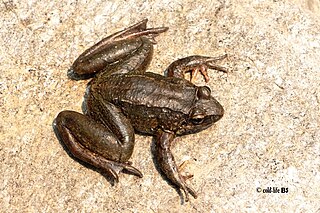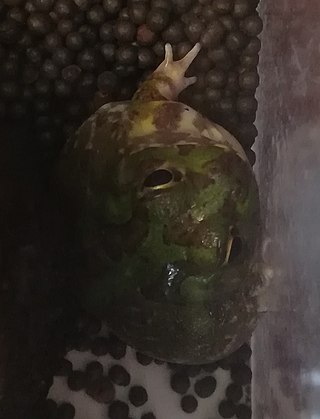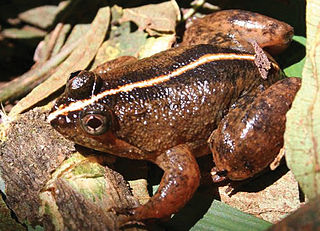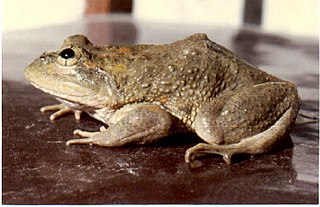
Conraua, known as slippery frogs or giant frogs is a genus of large frogs from sub-Saharan Africa. Conraua is the only genus in the family Conrauidae. Alternatively, it may be placed in the family Petropedetidae.

Microhyla ornata, commonly known as the ornate narrow-mouthed frog, ornate narrow-mouthed toad, or ornamented pygmy frog, is a species of microhylid frog found in South Asia. This amphibian is distributed in Kashmir, Nepal, peninsular India and the Andaman and Nicobar Islands, Sri Lanka, and Bangladesh. It was previously considered to be the same species as Microhyla fissipes; therefore, the aforementioned common names can refer to either species.

Ombrana is a monotypic genus of frogs in the family Dicroglossidae. It is represented by a single species, Ombrana sikimensis. The validity of this genus is currently considered uncertain.
Nyctibates is a monotypic genus of frog in the family Arthroleptidae; its sole species is Nyctibates corrugatus. Found in Cameroon, Equatorial Guinea, and Nigeria, its natural habitats are lowland forests in hilly areas, typically forests that have humid, but not marshy, floors; it requires tall forests with closed canopy. Breeding takes place in fast, rocky streams with clean water. There are no significant threats to this species.
Arlequinus is a genus of frogs in the family Hyperoliidae endemic to the Western High Plateau and Mount Cameroon, Cameroon. It is monotypic, being represented by the single species Arlequinus krebsi, commonly known as the Mebebque frog. Its natural habitats are dense tropical forest; it is threatened by habitat loss caused by wood cutting, agriculture, and human settlement.
Leptopelis modestus is a species of frog in the family Arthroleptidae. Its common names are modest forest treefrog and plain tree frog.

Chacophrys pierottii, the Chaco horned frog or lesser Chini frog, is a species of frog in the family Ceratophryidae. It is monotypic within the genus Chacophrys. It is found in the Chaco of northern Argentina, eastern Bolivia, and western Paraguay. Its natural habitats are dry shrubland and gallery forest. Outside the breeding season adults remain buried underground but emerge during the first heavy rains to breed in temporary ponds.

Macrogenioglottus is a genus of frogs in the family Odontophrynidae. It is monotypic, being represented by the single species, the Bahia forest frog. It is endemic to the Atlantic Forest of southeastern Brazil. Its natural habitats are primary and old secondary forests, but it can also live in agroforestry systems such as cacao plantations. Habitat loss is a potential threat to this species.
Phyzelaphryne miriamae, commonly known as Miriam's frog, is a species of frog in the family Eleutherodactylidae. It is endemic to Brazil where it is found in the drainage of Madeira and Tapajos rivers, in the southern Amazon Basin. It might also occur in Bolivia.
Pleurodema cinereum is a species of frog in the family Leptodactylidae. It is found in the Andes in northwestern Argentina, Bolivia, and southeastern Peru. Its common name is Juliaca four-eyed frog, after its type locality, Juliaca. Pleurodema borellii is possibly a junior synonym of this species.

Chaperina is a genus of frogs in the family Microhylidae. It is the only genus in the subfamily Chaperininae. It is also itself monotypic, being represented by the single species, Chaperina fusca, commonly known as the brown thorny frog, spiny-heeled froglet, and saffron-bellied frog. It is found on the Malay Peninsula, in Borneo and in the Philippines. It is abundant in Borneo but uncommon on the Malay Peninsula and patchily distributed in the Philippines.
Dasypops is a genus of frog in the family Microhylidae. It is monotypic, being represented by the single species, the Rio Mutum frog. It is endemic to the coastal plain of Espírito Santo and Bahia states of eastern Brazil. Its natural habitats are lowland forests, including secondary forests and forest edges. It is an explosive breeder that breeds in temporary pools. It is potentially threatened by habitat loss.

The southern torrent frog is a species of frog in the family Petropedetidae endemic to Tanzania, where it is found in the Uluguru, Udzungwa, and Mahenge Mountains. Frogs from the Nguru Mountains may represent an unnamed species.

Lankanectes corrugatus is a species of frog in the family Nyctibatrachidae. It was once monotypic within the genus Lankanectes, until the second species - Lankanectes pera was described in 2018 from Knuckles Mountain Range. It is endemic to Sri Lanka.

The common puddle frog, puddle frog, or yellow bellied puddle frog is a species of frog in the family Dicroglossidae. It has often been confused with Occidozyga sumatrana and records of this species outside the Philippines likely represent that species.

Chrysopaa is a genus of frogs in the family Dicroglossidae. It is monotypic, being represented by the single species, Chrysopaa sternosignata. It is found in Balochistan, Pakistan, Kashmir and in Afghanistan. Its common names include Baluch Mountain frog, karez frog, Malir paa frog, and Murray's frog.

The Natal ghost frog is a species of frog in the family Heleophrynidae. It is the only species in the genus Hadromophryne.

The frog family Dicroglossidae occurs in tropical and subtropical regions of Asia and Africa, with most genera and species being found in Asia. The common name of the family is fork-tongued frogs.

Craugastoridae, commonly known as fleshbelly frogs, is a family of New World direct-developing frogs. As delineated here, following the Amphibian Species of the World, it contains 129 species. They are found from the southern United States southwards to Central and South America.

Allopaa is a small genus of frogs in the family Dicroglossidae. Their distribution is restricted to Kashmir region of India and Pakistan. The phylogenetic placement of this genus has not been addressed with molecular methods and remains uncertain.















